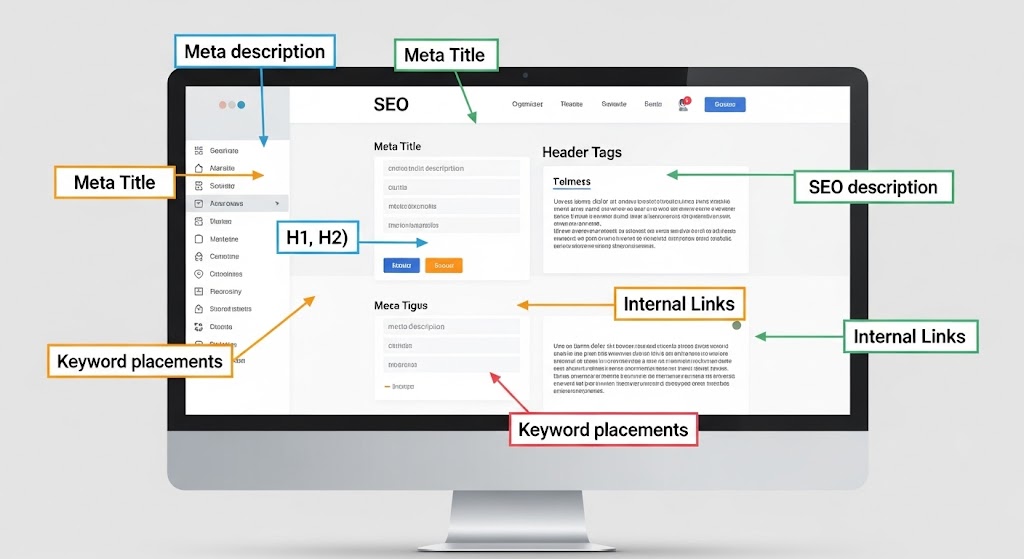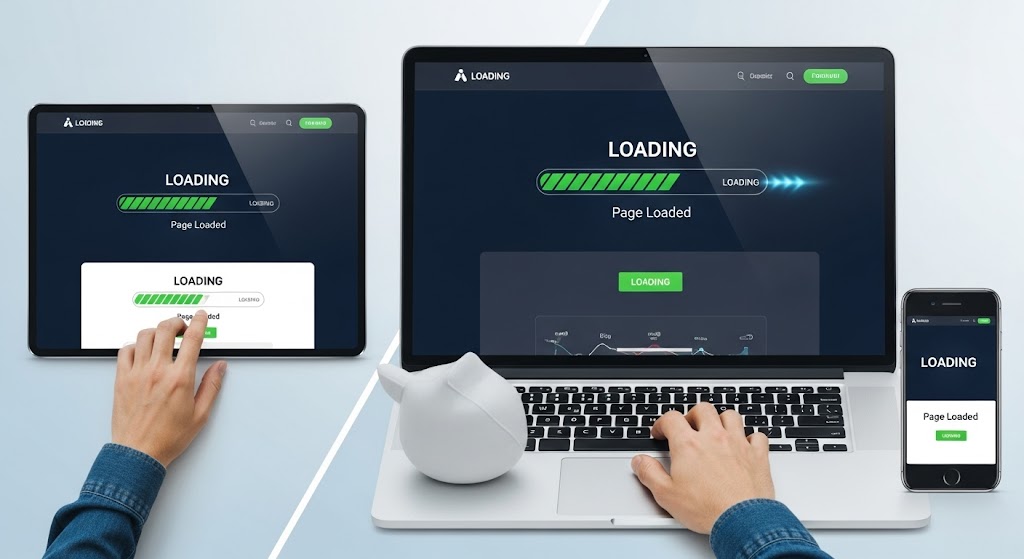Google is one of the top search engines, still generating the highest amount of organic search traffic. Proper optimization can bring your business into a new phase of online success.
Starting from the structure of the site, content structure, and complete SEO off-page factors that will definitely boost your organic visibility.
In this blog post, we’ll cover key strategies for improving your website's Google ranking, focusing on optimizing search intent, enhancing content quality, and implementing effective on-page SEO techniques.
How to Rank Your Site in Google: Google's Search Results

Your website can be optimized for better visibility. Let's explore the key processes: crawling, indexing, and serving.
Crawling
Crawling is the first step in Google's discovery of your website content.
- Overview: Google uses bots, called crawlers, to scan the internet. These bots explore your website pages and collect information.
- Importance: If Google can't crawl your site, it can't learn about your content. This means your site won't show up in search results.
Tips for Effective Crawling:
- Ensure your website is accessible to crawlers. Avoid using blocking technologies like specific JavaScript or Flash elements.
- Use a robots.txt file to guide crawlers on which pages to visit.
- Your sitemap can be submitted regularly through Google Search Console.
Indexing
Once your site is crawled, the next step is indexing.
- Explanation: Indexing is like creating a giant library of web pages. Google stores information about your site for future searches.
- Ensuring Proper Indexing: Make sure Google easily understands your pages.
Tips for Successful Indexing:
- Use clear titles and descriptions for each page.
- Implement proper use of header tags (H1, H2, etc.) to organize content.
- Google can better understand images if they have alt text.
Serving
Serving is the process where Google matches your content to what users are searching for.
- How It Works: When someone searches on Google, it looks through its index to find the best matches for the query.
- Factors Considered: Google considers the relevance, quality, and usability of the content to serve the most relevant results.
Tips for Better Serving:
- Focus on producing high-quality, relevant content that answers user queries.
- Mobile-friendly and fast-loading websites are a must.
- Updating your content regularly will keep it fresh and useful.
How to Rank Your Site in Google: 10 Tips
Boost your website's visibility on Google with these 10 essential tips. Master the art of SEO and increase your site's ranking effectively.
Target the Right Keywords
The right keywords are essential to getting your website noticed by Google. Keywords are what people type when they're looking for something online, and using the right ones will help more people find your site.
Importance of Keyword Research
Researching keywords is important because it helps you understand what people are searching for. This way, you can make your website show up in search results.
Factors to Consider:
- Volume: Look for keywords that many people search for. This means more potential visitors to your site.
- Keyword Difficulty (KD%): Some keywords are tough to rank for because many websites use them. Find a balance between those that are commonly used and those you can realistically rank for.
- Search Intent: Define the purpose of a particular keyword. Are they looking for information, trying to find a website, wanting to buy something, or completing a task? Match your content to what they need.
Prioritize Meeting Search Intent

To rank well on Google, it's crucial for your content to match what users are searching for. This is known as meeting search intent. Creating content based on different types of search intent satisfies users and boosts your site's visibility.
Types of Search Intent: 4 Types
Navigational Intent
Users search for brands or websites. They know what they want and are simply trying to find it quickly.
- Tip: Make sure your brand name and key pages are easily searchable. Use clear and consistent branding across your site to help users find you easily.
Informational Intent
Users with informational intent seek answers or knowledge. They might not be ready to buy but want to learn more about a topic.
- Tip: Create detailed, informative content like blog posts, guides, or FAQs. Use clear headings and bullet points to make information easy to find.
Commercial Intent
Commercial intent occurs when users are comparing products or services before making a decision. They want to know their options.
- Tip: Develop comparison pages or product reviews. For your offerings to stand out, emphasize their unique features and benefits.
Transactional Intent
When users are ready to make a purchase, they have transactional intent. They know what they want and are looking for the best place to buy.
- Tip: Optimize your product pages with clear calls to action and easy navigation. Build trust by providing detailed product descriptions and customer reviews.
Content Quality
It's crucial to create high-quality content that engages users and boosts your site's SEO. Quality content not only captures attention but also helps improve your search engine rankings. Below, we explore key aspects of content quality.
Original Content
Original content is crucial for standing out and providing value to your audience.
- Be Unique: Craft content that offers a fresh perspective or new information.
- Add Value: Ensure your content solves problems or answers questions your audience cares about.
- Avoid Copying: Steer clear of duplicating content from other sites to maintain credibility and avoid penalties.
Regular Updates
Maintaining your content's relevance and authority.
- Stay Current: Update your content with the latest information and trends.
- Refresh Old Posts: Regularly revisit and revise older posts to keep them accurate and useful.
- Encourage Return Visits: Fresh content encourages users to revisit your site, boosting engagement.
Readability
Content should be easy to read and understand, even for younger audiences.
- Use Simple Language: Write in clear and straightforward language to ensure everyone understands your message.
- Short Paragraphs: Break up text into short, digestible paragraphs.
- Include Visuals: Use images and infographics to enhance understanding and engagement.
On-Page SEO: Boosting Your Site’s Ranking

Optimizing each page of your website is crucial for improving your search engine rankings. On-page SEO involves making adjustments directly on your website to make it more search engine friendly. Here’s how you can enhance your site’s visibility through effective on-page SEO strategies.
Title Tags and Meta Descriptions
Meta descriptions and title tags are like the cover and blurb of a book. You can use them to tell search engines and users what your page is about.
- Craft Compelling and Relevant Titles
- Use keywords naturally in your titles.
- Keep titles under 60 characters to avoid being cut off in search results.
- Make sure each page has a unique title.
- Write Concise and Informative Meta-descriptions
- Summarize the page content in 155-160 characters.
- Include a call-to-action to entice clicks.
- Ensure meta descriptions are unique for each page.
Header Tags
Using header tags properly structures your content and helps search engines understand your page hierarchy.
- Structure Content with H1, H2, and H3 Tags
- Your main title should be in one H1 tag.
- Break content into sections with H2 tags.
- Use H3 tags for sub-sections under H2 headings.
- Include keywords in your header tags where relevant.
Image Optimization
Images can make your page more engaging, but they need to be optimized to improve page speed and accessibility.
- Use Alt Text for Images
- Describe images using keywords, but keep it relevant.
- Search engines can optimize images by adding alt text.
- Compress Images for Faster Load Times
- Keep image quality while reducing file size.
- Faster load times improve user experience and ranking.
Use Internal Links
Internal links are hyperlinks that connect different pages on your website. They play a crucial role in improving both site navigation and search engine optimization (SEO).
- Improves Navigation: Internal links help users easily find related content on your site, enhancing the overall user experience.
- Boosts SEO: These links distribute page authority across your site, increasing search engine recognition of your content.
Best Practices for Internal Linking:
- Use Descriptive Anchor Text: Ensure the clickable text in your link clearly describes the content of the linked page.
- Link to Relevant Pages: Connect pages that are contextually related to provide value to the user and improve SEO.
- Limit Links Per Page: Avoid cluttering pages with too many links to maintain a clean and focused user experience.
Backlinks
Your website receives backlinks from other websites. They act as endorsements, signaling to search engines that your site is trustworthy and authoritative.
- Quality over Quantity: It's better to have a few high-quality backlinks from reputable sites than numerous links from low-quality sources. Obtain links from industry-recognized sites.
- Guest Blogging: Writing guest posts for influential blogs in your niche is a great way to earn backlinks. When you provide valuable content, your site will be linked to.
- Building Relationships: Networking with other website owners can open up opportunities for backlinks. Collaborate and create mutually beneficial link-sharing relationships.
Make Your Site Mobile-Friendly
In today's world, most people use their phones to browse the internet. This makes it crucial for websites to work well on mobile devices. Having a mobile-friendly site boosts your chances of ranking higher on Google.
Why Mobile Responsiveness is Crucial for SEO Success
- Increased Mobile Traffic: More users are accessing websites via mobile devices.
- Improved User Experience: A site that adapts to different screen sizes keeps visitors engaged.
- Higher Search Rankings: Google favors mobile-friendly sites in search results.
Tools and Tips for Ensuring Your Site Performs Well on Mobile Devices
- Responsive Design: Use designs that adjust to any screen size automatically.
- Mobile Testing Tools: Tools like Google's Mobile-Friendly Test can help check how your site appears on mobile devices.
- Simplify Navigation: Ensure menus and links are easy to tap and read.
Prioritize Fast Loading Times

Fast loading times are vital for keeping users on your site and ensuring a smooth browsing experience. The speed of your website is one of Google's ranking factors, so it's important to make sure your website loads quickly.
The Role of Site Speed in User Experience and Rankings
- Reduced Bounce Rate: Faster sites keep visitors from leaving too soon.
- Better User Satisfaction: Quick loading improves how users feel about your website.
- Higher Rankings: Google ranks sites faster and higher in search results.
Tools to Test and Improve Loading Times
- PageSpeed Insights: Use this tool to analyze your site's speed and get suggestions for improvement.
- Compress Images: Reduce image sizes to speed up load times without losing quality.
- Minimize Code: Simplify HTML, CSS, and JavaScript files to enhance speed.
Fix Any Technical Issues
To rank high on Google, it's important to make sure your website works correctly. Technical issues can stop your site from showing up in search results. Let's explore some common problems and how to fix them.
Common Technical SEO Problems
Technical issues can hide your website from Google. Here are some common problems that can affect your site's performance:
- Broken Links: These are links that don't work. They lead to a page that doesn't exist anymore. Fixing these helps visitors reach the right pages.
- 404 Errors: This error means a page can't be found. It happens when a page is moved or deleted. Fixing 404 errors improves user experience and keeps visitors on your site.
- Incorrect Indexing: This happens when search engines don't read your site correctly. It can stop your pages from appearing in search results. Make sure all your important pages are indexed properly.
Importance of Regular Site Audits
Regular checks, or audits, of your website can help keep it healthy. Here’s why they matter:
- Catch Problems Early: Regular audits help you find and fix issues before they become bigger problems.
- Improve User Experience: A well-maintained site runs smoothly and keeps visitors happy.
- Boost Search Rankings: Fixing technical issues can help Google rank your site higher.
Improve Your Local SEO
To make sure people in your area can find your website, you need to focus on Local SEO. This means making your site show up in local search results. Here’s how to do it:
Optimize for Local Search Queries
Local search queries are when people look for businesses or services near them. Here’s how to make sure your site shows up:
- Use Local Keywords: Include the name of your city or region in your website content and meta tags.
- Location-Specific Content: Create pages or blog posts that focus on local news, events, or activities.
Importance of Google My Business
Setting up Google My Business correctly can make a big difference in how your business appears in local search results.
- Claim Your Listing: Verify that your business is listed, and claim it if it’s not.
- Update Regularly: Keep your business hours, contact information, and address up to date.
- Encourage Reviews: Ask happy customers to leave positive reviews, which can boost your ranking.
Additional Ranking Factors
For your site to rank on Google, there are several important factors to consider beyond just keywords and content. Let's explore some of these crucial elements that can significantly impact your site's ranking.
Secure Sockets Layer (SSL)

Using SSL is essential for keeping user data safe and secure. It shows visitors that your site can be trusted.
- Use HTTPS: Ensure your website URL starts with "https://" to indicate a secure connection.
- Build Trust: A secure site can increase user confidence and reduce bounce rates.
- Improved Rankings: Google tends to favor secure sites in search results.
Structured Data
As a result, your site content can be understood by search engines better, which can improve your search visibility.
- Schema Markup: Add schema markup to your HTML to help Google understand your page.
- Rich Snippets: Enable rich snippets in search results, which can lead to higher click-through rates.
- Enhanced Display: Provide additional information about your site in search listings.
User Engagement Metrics
User engagement metrics give insight into how visitors interact with your site, which can influence your ranking.
- Monitor Bounce Rates: High bounce rates can negatively impact your ranking; aim for engaging content.
- Dwell Time: Encourage visitors to stay longer by offering valuable content.
- Interactive Features: Use quizzes, videos, or infographics to keep users engaged.
Social Proof
Credibility and trust can be built by displaying social proof to your audience, factors that can positively affect your ranking.
- Reviews and Testimonials: Display customer feedback prominently on your site.
- Social Shares: Encourage sharing of your content to increase visibility and reach.
- User-Generated Content: Embrace user contributions, such as reviews or comments, to enhance authenticity.
Key Factors that Impact Search Rankings
Google considers several key factors when ranking websites. Optimizing your content is easier when you understand these factors.
Meaning and Intent
Google tries to understand what users mean when they search for something. Here's how you can match your content with user intent:
- Use Clear Language: Write clearly so that your content matches what users are looking for.
- Focus on Keywords: Use keywords that match the search queries your audience uses.
- Answer Questions: Provide answers to common questions related to your topic.
Relevance
Your content should closely relate to what the user wants. Relevance is crucial for higher rankings.
- Stay On-Topic: Make sure your content directly relates to your audience's needs.
- Use Appropriate Keywords: Include keywords that align with the search intent.
- Update Content Regularly: Keep your information current and useful.
Quality
Google looks at how good your content is. High-quality content usually ranks better.
- Show Expertise: Provide well-researched and accurate information.
- Be Authoritative: Establish yourself as a knowledgeable source.
- Build Trust: Ensure that your content is reliable and trustworthy.
User Experience
A good user experience can improve your site's ranking. Google values sites that are easy to use.
- Mobile-Friendliness: Ensure your site works well on phones and tablets.
- Fast Loading Speed: Make sure your pages load quickly.
- Easy Navigation: Design your site so users can find information easily.
Context and Location
Google uses context and location to show results that are more relevant to users.
- Local SEO: Make your site search engine-friendly, especially if you have a physical location.
- Use Local Keywords: Include location-based keywords where applicable.
- Claim Your Business: Make sure your business is listed on Google Maps.
Conclusion
Ranking high on Google’s search results is a journey that requires a strategic approach. By targeting the right keywords, aligning your content with user intent, and maintaining high content quality, you’re setting the foundation for improved visibility and traffic.
You will receive consistent web traffic, reach a highly targeted audience, and boost your site's credibility.
Implementing these strategies not only propels your site to the top but also ensures long-term SEO success, providing you with a cost-effective way to maintain growth and build a strong online presence.

